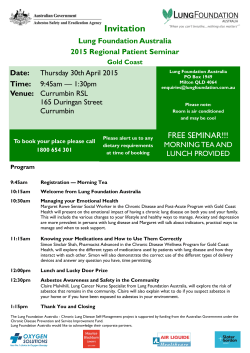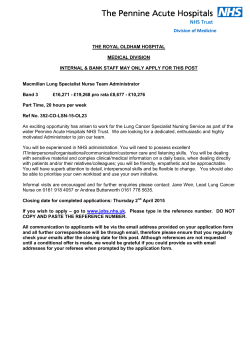
Heart Disease Questions BIOL1
Q1. (a) The heart controls and coordinates the regular contraction of the atria and ventricles. Describe how. ........................................................................................................................ ........................................................................................................................ ........................................................................................................................ ........................................................................................................................ ........................................................................................................................ ........................................................................................................................ ........................................................................................................................ ........................................................................................................................ ........................................................................................................................ ........................................................................................................................ (Extra space) ................................................................................................. ........................................................................................................................ ........................................................................................................................ ........................................................................................................................ ........................................................................................................................ ........................................................................................................................ ........................................................................................................................ ........................................................................................................................ ........................................................................................................................ ........................................................................................................................ ........................................................................................................................ ........................................................................................................................ ........................................................................................................................ ........................................................................................................................ (5) Page 1 of 14 (b) The diet of a person can increase the risk of coronary heart disease. Explain how. ........................................................................................................................ ........................................................................................................................ ........................................................................................................................ ........................................................................................................................ ........................................................................................................................ ........................................................................................................................ ........................................................................................................................ ........................................................................................................................ ........................................................................................................................ ........................................................................................................................ (Extra space) ................................................................................................. ........................................................................................................................ ........................................................................................................................ ........................................................................................................................ ........................................................................................................................ ........................................................................................................................ ........................................................................................................................ ........................................................................................................................ ........................................................................................................................ ........................................................................................................................ ........................................................................................................................ ........................................................................................................................ (5) (Total 10 marks) Page 2 of 14 Q2. (a) The sinoatrial node (SAN) is in the right atrium of the heart. Describe the role of the sinoatrial node. ...................................................................................................................... ...................................................................................................................... ...................................................................................................................... ...................................................................................................................... (2) Ten years ago, a woman was found to have a high concentration of cholesterol in her blood. As a result, she was put on a special diet. She has been on this diet ever since. Four years after starting the diet, she started taking a drug to lower her blood cholesterol. The graph shows the concentration of cholesterol in her blood over the ten-year period. (b) Describe how the concentration of cholesterol in her blood changed over the ten-year period. ...................................................................................................................... ...................................................................................................................... ...................................................................................................................... ...................................................................................................................... ...................................................................................................................... (2) Page 3 of 14 (c) Explain the overall change in cholesterol concentration in the blood in the first two years. ...................................................................................................................... ...................................................................................................................... ...................................................................................................................... ...................................................................................................................... ...................................................................................................................... (2) (d) Use the graph to evaluate the success of the special diet and of the drug in reducing the risk of coronary heart disease. ...................................................................................................................... ...................................................................................................................... ...................................................................................................................... ...................................................................................................................... (2) (Total 8 marks) Q3. Read the following passage. Several diseases are caused by inhaling asbestos fibres. Most of these diseases result from the build up of these tiny asbestos fibres in the lungs. 5 10 One of these diseases is asbestosis. The asbestos fibres are very small and enter the bronchioles and alveoli. They cause the destruction of phagocytes and the surrounding lung tissue becomes scarred and fibrous. The fibrous tissue reduces the elasticity of the lungs and causes the alveolar walls to thicken. One of the main symptoms of asbestosis is shortness of breath caused by reduced gas exchange. People with asbestosis are at a greater risk of developing lung cancer. The time between exposure to asbestos and the occurrence of lung cancer is 20–30 years. Use information in the passage and your own knowledge to answer the following questions. (a) Destruction of phagocytes (lines 4–5) causes the lungs to be more susceptible to infections. Explain why. ...................................................................................................................... ...................................................................................................................... ...................................................................................................................... ...................................................................................................................... (2) Page 4 of 14 (b) (i) The reduced elasticity of the lungs (lines 6–7) causes breathing difficulty. Explain how. ............................................................................................................. ............................................................................................................. ............................................................................................................. ............................................................................................................. (2) (ii) Apart from reduced elasticity, explain how changes to the lung tissue reduce the efficiency of gas exchange. ............................................................................................................. ............................................................................................................. ............................................................................................................. ............................................................................................................. ............................................................................................................. ............................................................................................................. ............................................................................................................. ............................................................................................................. (4) (c) (i) Doctors did not make the link between exposure to asbestos and an increased risk of developing lung cancer for many years. Use information in the passage to explain why. ............................................................................................................. ............................................................................................................. (1) (ii) Give one factor, other than asbestos, which increases the risk of developing lung cancer. ............................................................................................................. (1) (Total 10 marks) Page 5 of 14 Q4. Lung cancer, chronic bronchitis and coronary heart disease (CHD) are associated with smoking. Tables 1 and 2 give the total numbers of deaths from these diseases in the UK in 1974. Table 1 Men Age/years Number of deaths (in thousands) lung cancer chronic bronchitis coronary heart disease 35 - 64 11.5 4.2 31.7 65 - 74 12.6 8.5 33.3 75+ 5.8 8.1 29.1 Total (35 - 75+) 29.9 20.8 94.1 Table 2 Women Age/years (a) Number of deaths (in thousands) lung cancer chronic bronchitis coronary heart disease 35 – 64 3.2 1.3 8.4 65 – 74 2.6 1.9 18.2 75+ 1.8 3.5 42.3 Total (35 – 75+) 7.6 6.7 68.9 (i) Using an example from the tables, explain why it is useful to give data for men and women separately. ............................................................................................................. ............................................................................................................. ............................................................................................................. (2) (ii) Data like these are often given as percentages of people dying from each cause. Explain the advantage of giving these data as percentages. ............................................................................................................. ............................................................................................................. ............................................................................................................. ............................................................................................................. (2) Page 6 of 14 (b) Give two factors, other than smoking, which increase the risk of coronary heart disease. Factor 1 ........................................................................................................ ...................................................................................................................... Factor 2 ........................................................................................................ ...................................................................................................................... (2) (Total 6 marks) Q5. (a) (i) What is atheroma? ............................................................................................................. ............................................................................................................. ............................................................................................................. ............................................................................................................. (2) (ii) Atheroma makes it more likely that a blood clot will form. Describe how a blood clot may lead to a myocardial infarction. ............................................................................................................. ............................................................................................................. ............................................................................................................. ............................................................................................................. ............................................................................................................. ............................................................................................................. (3) Page 7 of 14 (b) The graph shows the relationship between the amount of dairy fat eaten and the deaths from coronary heart disease (CHD) in different countries. (i) The number of deaths is given per 100 000 people. Explain why. ............................................................................................................. ............................................................................................................. ............................................................................................................. ............................................................................................................. ............................................................................................................. ............................................................................................................. (2) (ii) Does the evidence from the graph show that eating dairy fat causes coronary heart disease? Explain your answer. ............................................................................................................. ............................................................................................................. ............................................................................................................. ............................................................................................................. ............................................................................................................. (2) (Total 9 marks) Page 8 of 14 Q6. (a) Explain the link between atheroma and the increased risk of aneurism. ...................................................................................................................... ...................................................................................................................... ...................................................................................................................... ...................................................................................................................... ...................................................................................................................... ...................................................................................................................... ...................................................................................................................... ...................................................................................................................... (4) (b) Cigarette smoking and a diet high in saturated fat increase the risk of myocardial infarction. Explain how. ...................................................................................................................... ...................................................................................................................... ...................................................................................................................... ...................................................................................................................... ...................................................................................................................... ...................................................................................................................... ...................................................................................................................... ...................................................................................................................... ...................................................................................................................... ...................................................................................................................... ...................................................................................................................... ...................................................................................................................... (6) (Total 10 marks) Page 9 of 14 (a) M1. 1. SAN → AVN → bundle of His /Purkyne fibres; 1. Mark for correct sequence 2. Impulses / electrical activity (over atria); 3. Atria contract; 4. Non-conducting tissue (between atria and ventricles); 5. Delay (at AVN) ensures atria empty / ventricles fill before ventricles contract; 6. Ventricles contract from apex upwards; 5 max (b) 1. Too much saturated fat / cholesterol in diet; 1. Accept: Too much salt / alcohol 2. Increase in LDL / cholesterol in blood; 3. Atheroma / fatty deposits / plaques in artery walls; 4. Reduces diameter of / blocks coronary arteries; 5. Less oxygen / glucose to heart muscle / tissue / cells; 6. Increase in blood pressure; Marking points 6 and 7 can be awarded in the context of salt 7. (Increased risk of) clot / thrombosis / embolism / aneurysm; 5 max [10] M2. (a) Sends out electrical activity/ impulses; Initiates the heartbeat / acts as a pacemaker / (stimulates) contraction of atria; Q Ignore reference to ventricles. 2 (b) Fluctuation and overall decrease; Steep decrease first/after two years and then gradual decrease; 2 (c) Diet low in cholesterol/LDLs; Less absorbed into blood/ from intestines; 2 Page 10 of 14 (d) Diet has greater effect in decreasing blood cholesterol concentration; Difficult to judge effect of drug as it is used at same time as diet / drug is not used on its own; Decrease in blood cholesterol concentration linked to reduced risk of heart disease; Q Allow converse for third marking point. 2 max [8] M3. (a) Phagocytes engulf/ingest pathogens/microorganisms/bacteria/viruses; Phagocytes destroy pathogens/microorganisms/bacteria/viruses; Lung diseases are caused by pathogens/microorganisms/bacteria/viruses; Q Allow description of process of engulfing 2 max (b) (i) Alveoli/lungs will not inflate/deflate fully/reduced lung capacity; Breathing out particularly affected/no longer passive; Concentration/diffusion gradient / rate of diffusion reduced; 2 max (ii) Alveolar walls thicken; Longer diffusion pathway; Scarred/fibrous tissue; Reduces surface area (for gaseous exchange); Q Diffusion is essential for 2nd point and surface area for 4th point. 4 (c) (i) Cancer develops 20 – 30 years after exposure (to asbestos); 1 (ii) Smoking / air pollution / specified industrial source; 1 [10] M4. (a) (i) because there are big differences; any correct named example e.g. lung cancer/bronchitis much lower in women than in men; 2 (ii) easier to compare if sample size effectively the same; different numbers of people in each group; 2 Page 11 of 14 (b) ANY TWO: more stress / more saturated fats in diet / less time to exercise / reliance on cars; 2 [6] M5. (a) (i) Cholesterol/ lipoprotein/ fatty material/cells; Reject fatty acid In the artery wall/under lining/endothelium of artery/blood vessel; Q Do not accept references to veins or capillaries as equivalent to blood vessels 2 (ii) (Trapped in) coronary artery/artery supplying heart muscle/ tissue/cells; i.e. material of heart wall Prevents oxygen; Reaching (heart muscle/tissue); (Heart muscle) dies/stops respiring; 3 max (b) (i) Allows comparison; Different number of people in each country; 2 (ii) Correlation does not show causation / graph only shows correlation Something else/another named factor may be involved such as lack of fibre/smoking/stress;; Related to both CHD and dairy fat; 2 max [9] M6. (a) Fatty material within walls of arteries; Vessels narrow; Blood pressure rises; Weakened blood vessels may burst; 4 (b) Carbon monoxide combines with haemoglobin/causes less oxygen to be transported; Decreases concentration of antioxidants in blood; Increases the damage done to artery walls; Blood clot may occur;* Blood pressure increased* Blocks flow of blood to heart/in carotid arteries;* (4 max) Page 12 of 14 Saturated fat associated with cholesterol; Cholesterol deposited in arteries; Atheroma formation; Blood clot may occur*; Blood pressure increased* Blocks flow of blood to heart/in carotid arteries*; (4 max) *Allow reference to these points only once. Cholesterol / blood clot causes constriction of coronary arteries; Less oxygen transported to heart muscle tissue; Q Do not allow credit for such expressions as “furring up arteries”, “putting strain on the heart” and “bad cholesterol” 6 max [10] Page 13 of 14 Page 14 of 14
© Copyright 2025









